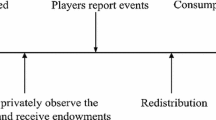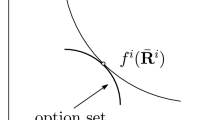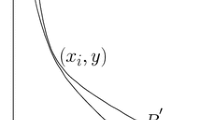Abstract
In large quasilinear economies, we provide sufficient conditions to establish the nonemptiness of several versions of approximate interim cores with endogenous communication. This is done by proving nonemptiness of approximate ex post cores satisfying incentive compatibility. Our model features a finite number of agents whose information is exclusive, whom we shall term “monopolists of scarce information.” When the number of agents with exclusive information remains finite, the main argument relies on an adaptation of the small group effectiveness condition, previously proposed for games of complete information.
Similar content being viewed by others
Notes
Ex post—that is, given the realized state of the economy—in the economies we consider, the core is nonempty. The interim core relates to blocking opportunities at the interim stage, prior to the realization of the state of the economy. In particular, the coarse core is the core that results when agents, in forming coalitions and maximizing interim expected utilities, can only use the information that is commonly known to all agents in the coalition. The fine core allows all kinds of information transmission within the coalition. The incentive-compatible versions of these cores impose incentive constraints on the allocations and on the transmission of information.
As explained in Serrano and Vohra (2007), a sort of revelation principle can be invoked: the equilibrium of the communication mechanism used by the coalition is outcome-equivalent to a truth-telling equilibrium in a direct voting mechanism.
To show that our main result is nonvacuous, it is essential to show that SGE holds for a class of economies satisfying the conditions of our paper. While the implications of SGE have been considered in a number of papers, such a result has not previously been established.
This core is referred to in Kamishiro and Serrano (2011) as the core w.r.t. equilibrium blocking of unrestricted random communication mechanisms.
See e.g., Forges, Minelli and Vohra (2002b, page 8) and Vohra (1999) for discussions of the incentive compatibility conditions.
Defining the set of states as the product over finite sets of informational types is convenient. In this case, the dimensionality of the state space does not increase after increasing the number of agents; see, e.g., Serrano et al. (2001).
For example, let the set of characteristics, N, be \(\{a,b,c\}\). Then, an example of a profile is \(f(a)=1\), \(f(b)=2\), and \(f(c)=0\). This profile f describes an economy with one agent having characteristic a and two agents with characteristic b.
To illustrate, return to our prior example, with \(N=\{a,b,c\}\) and \(f(a)=1,f(b)=2\) and \(f(c)=0.\) An example of a partition of f is \( \{f^{1},f^{2}\}\) where \(f^{1}(a)=1,f^{1}(b)=1\), \(f^{1}(c)=0\) and \( f^{2}(a)=0,\)\(f^{2}(b)=1,\ f^{2}(c)=0.\) We shall use partitions associated with subprofiles of a given profile. In our context, the terminology “a partition of a profile” is natural since it describes a partition of the set of agents described by a profile.
Equivalently, \(\Psi (f,t)\) can also be expressed as follows:
$$\begin{aligned} \Psi (f,t)=\max _{\mathrm{partitions } \{f^{k}\}\mathrm{of } f} \max _{(x_i)} f^{k}(i)u_{i}(x_{i},t)\quad \text{ subject } \text{ to }\quad \sum _{i\in N}f^{k}(i)[e_{i}-x_{i}]=0. \end{aligned}$$See Allen and Yannelis (2001) for another survey covering a different line of work in economies with asymmetric information.
Our nonemptiness result relies on this inclusion relationship, whose proof heavily rests on quasilinearity.
Postlewaite and Schmeidler (1986) use the terminology “nonexclusivity in information” to describe an information structure in which the information of any one agent can be deduced by pooling the information of all the others.
There are other notions of approximate cores that involve ignoring a relatively small set of agents. Such notions are not appropriate for our work since we do not want to ignore small sets of agents containing agents with scarce information.
See Sect. 4.4 for a discussion of some of the literature on \(\varepsilon \)-cores of large games and economies.
In the complete information setting, exact efficiency is required for the approximate core, but, more consistent with the approximate blocking idea, only approximate efficiency is required for the approximate core in the incomplete information setting.
It is relatively easy to show that SGE implies per capita boundedness: SGE implies that, given \(\varepsilon >0\), almost all gains to cooperation can be achieved by partitioning the set of players into groups bounded in size. But such groups have a maximum per capita payoff and increasing the size of the economy can increase the per capita payoff by only \(\varepsilon \) per capita. The other direction is more subtle. Roughly, if there are no scarce types, then each player has many near substitutes, so no one player can achieve an arbitrarily large payoff when the set of players goes to infinity since close substitutes can compete and keep any player from holding out for a large payoff.
It is well known that, with strictly concave utility functions, there is a unique allocation of commodities that maximizes total utility.
The topology is the usual one on finite dimensional vectors of rational numbers.
Since the possibilities of trade for a coalition include trading within coalitions in a partition of players into smaller coalitions, this expression must be nonnegative (superadditivity, in game theoretic terms).
Moreover, Wooders (2010) shows that, with only per-capita boundedness and without SGE, cores may treat even players of abundant types (in complete information games) unequally.
Wooders (1983) studied a model with nontransferable utility. The model is an extension of earlier State University of Stony Brook and Cowles Foundation, Yale University, working papers treating TU games satisfying simply boundedness of per capita payoffs.
See Wooders (2010, Example 4) for a situation with one unique player and multiple copies of other players. Without the condition of SGE it is shown that there are \(\varepsilon \)-core allocations, \(\varepsilon =0\), that assign each player of the abundant type a different payoff. It is noteworthy that the celebrated Debreu and Scarf (1963) results, as the authors acknowledge, rely heavily on the equal treatment of identical players.
Another paper, Khan (1974) has some indirect relevance. It provides conditions on economies to underlie the continuum models of Grodal (1972), Schmeidler (1972), and Vind (1972) showing that in the continuum coalitions can be restricted to be of small measure or of large measure and core-equivalence still holds. The Kaneko and Wooders (1989) and Hammond et al. (1989) papers show that coalitions in the continuum can be restricted to be limits of vanishingly small proportions of the population, and thus of measure zero, a limit form of SGE.
An assumption used in Wooders (1983) and other papers by Wooders and her coauthors.
References
Allen B, Yannelis N (2001) Differential information economies: introduction. Econ Theor 18:263–273
Allouch N, Wooders M (2008) Price Taking equilibrium in economies with multiple memberships in clubs and unbounded club sizes. J Econ Theory 140:246–278
Anderson R (1978) An elementary core equivalence theorem. Econometrica 46:1483–1487
Aumann RJ (1964) Markets with a continuum of traders. Econometrica 32:39–50
Berge C (1963) Topological spaces. Macmillan, New York
Debreu G, Scarf H (1963) A limit theorem on the core of an economy. Int Econ Rev 4:235–246
Dutta B, Vohra R (2005) Incomplete information, credibility and the core. Math Soc Sci 50:148–165
Forges F, Mertens J-F, Vohra R (2002a) The ex ante incentive compatible core in the absence of wealth effects. Econometrica 70:1865–1892
Forges F, Minelli E, Vohra R (2002b) Incentive and the core of an exchange economy: a survey. J Math Econ 38:1–41
Forges F, Serrano R (2013) Cooperative games with incomplete information: some open problems. Int Game Theory Rev 15:301–317
Gabszewicz J-J (1977) Asymmetric Duopoly and the core. J Econ Theory 14:172–179
Gabszewicz J-J, Shitovitz B (1992) The core in imperfectly competitive economies. In: Aumann R, Hart S (eds) Handbook of game theory with economic applications, vol 1. North-Holland, Amsterdam, pp 459–483
Grodal B (1972) A second remark on the core of an atomless economy. Econometrica 40(3):581–583
Hammond P, Kaneko M, Wooders MH (1989) Continuum economies with finite coalitions: core, equilibria and widespread externalities. J Econ Theory 49:113–134
Kamishiro Y, Serrano R (2011) Equilibrium blocking in large quasilinear economies. Math Oper Res 36:552–567
Kamishiro Y, Serrano R, Wooders M (2015) Information and small group effectiveness in large quasilinear economies. Working Paper 2015-11, Department of Economics, Brown University
Kaneko M, Wooders M (1989) The core of a continuum economy with widespread externalities and finite coalitions: from finite to continuum economies. J Econ Theory 49:135–168
Khan MA (1974) Some remarks on the core of a large economy. Econometrica 42:633–642
Khan MA (1976) Oligopoly in markets with a continuum of traders: an asymptotic interpretation. J Econ Theory 12:273–297
Khan MA, Rashid S (1978) A limit theorem for an approximate core of a large but finite economy. Econ Lett 1:297–302
Kovalenkov A, Wooders M (2001) An exact bound on epsilon for nonemptiness of epsilon cores of games. Math Oper Res 26(4):654–678
Kovalenkov A, Wooders M (2003) Approximate cores of games and economies with clubs. J Econ Theory 110:87–120
Liu Q, Mailath GJ, Postlewaite A, Samuelson L (2014) Stable matching with incomplete information. Econometrica 82:541–587
Myerson RB (1991) Game theory: analysis of conflict. Harvard University Press, Cambridge, MA
Myerson RB (2007) Virtual utility and the core for games with incomplete information. J Econ Theory 136:260–285
Postlewaite A, Schmeidler D (1986) Implementation in differential information economies. J Econ Theory 39:14–33
Qin C-Z (1993) The inner core and the strictly inhibitive set. J Econ Theory 59:96–106
Schmeidler D (1972) A remark on the core of an atomless economy. Econometrica 40:579–580
Serrano R, Vohra R (2007) Information transmission in coalitional voting games. J Econ Theory 134:117–137
Serrano R, Vohra R, Volij O (2001) On the failure of core convergence in economies with asymmetric information. Econometrica 69:1685–1696
Shapley LS, Shubik M (1966) Quasi-cores in a monetary economy with nonconvex preferences. Econometrica 34:805–827
Vind K (1972) A third remark on the core of an atomless economy. Econometrica 40:585–586
Vohra R (1999) Incomplete information, incentive compatibility and the core. J Econ Theory 86:123–147
Wilson R (1978) Information, efficiency and the core of an economy. Econometrica 46:807–816
Winter E, Wooders M (2008) On large games with bounded essential coalition sizes. Int J Econ Theory 4:191–206
Wooders M (1983) The epsilon core of a large replica game. J Math Econ 11:277–300
Wooders M (1992) Inessentiality of large groups and the approximate core property; an equivalence theorem. Econ Theor 2:129–147
Wooders M (1994) Equivalence of games and markets. Econometrica 62:1141–1160
Wooders M (2010) Cores of many player games: nonemptiness and equal treatment. Rev Econ Des 14:131–162
Author information
Authors and Affiliations
Corresponding author
Additional information
Publisher's Note
Springer Nature remains neutral with regard to jurisdictional claims in published maps and institutional affiliations.
This version has grown out of a previous working paper [KSW (2015)]. We are grateful to an Associate Editor and three anonymous referees for helpful comments. We also thank seminar audiences at the University of Kansas and Yokohama National University, and participants at the 22nd Decentralization Conference in Japan. Kamishiro’s research is partially supported by KAKENHI (JP16H03121). Wooders gratefully acknowledges support from National Science Foundation # 422-422-3491 and from the Douglas Grey Fund for Research in Economics at Vanderbilt University.
Rights and permissions
About this article
Cite this article
Kamishiro, Y., Serrano, R. & Wooders, M. Monopolists of scarce information and small group effectiveness in large quasilinear economies. Int J Game Theory 50, 801–827 (2021). https://doi.org/10.1007/s00182-021-00769-x
Accepted:
Published:
Issue Date:
DOI: https://doi.org/10.1007/s00182-021-00769-x
Keywords
- Asymmetric information
- Large quasilinear economies
- Exclusive information
- Small group effectiveness
- Approximate cores




